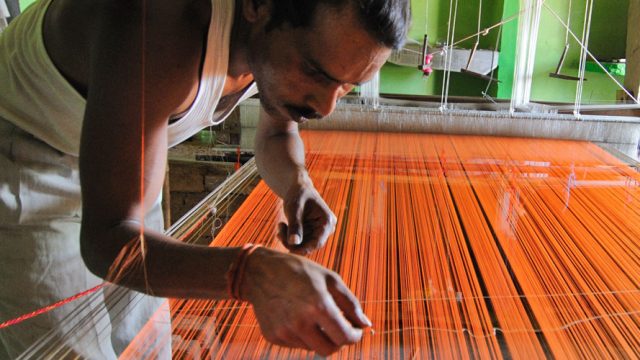After catching a blissful sunrise that gilded the Narmada River, we walked across the Ahilyeshwar Temple, and up to the ramparts of Ahilya Fort. The silence was broken by the unmistakable rat-a-tat of looms. We followed the staccato clatter into Rehwa Society, a not-for-profit weaver’s cooperative for local women. Noticing us, the women paused for a brief moment, and went back to work.

Though the tradition of weaving in the ancient temple town of Maheshwar dates back to the 5th century, it was popularized during the reign of Maratha queen Rani Ahilyabai Holkar (1767-1795). She invited master weavers from Surat and South India to create traditional Nauvari or Maharashtrian-style nine-yard saris, and turbans—giving them as gifts to visiting royals. When the privy purse was abolished after India’s independence, Maheshwar’s weaving tradition went into decline. Until 1978, when Shivajirao Richard Holkar, scion of the Holkar family, and his former wife Sally decided to revive it by founding the Rehwa Society. This endeavour spurred the growth of the local textile industry and turned the Maheshwari sari into a brand name.

Despite their subtle and simple style, Maheshwari saris exude charm and sophistication. Silk thread is used in the warp (tana), and cotton in the weft (bana), imparting to the fabric, a lovely, silken sheen. It is light and comfortable to drape, an ideal choice in the region’s hot weather.
The uniqueness of Maheshwari saris lies in the weave. The body of the sari has small checks, stripes, or can be plain, but the typically striped pallu and border designs are inspired by traditional motifs, or architectural embellishments found in the town’s temples and monuments.

Nearly 800 families in Maheshwar are involved in the weaving business. At Rehwa, 70 local ladies, and a few men, weave in shifts. We sat beside some shy, smiling weavers who showed us designs with descriptive names—rui phool (cotton flower), diya (lamp), chameli (jasmine), hans (swan) and bugudi (reversible). There was a wavy border pattern is called “Narmadaji” or leheriya, inspired by the river’s ripples. The arrowhead design was called “V-border”, the karvat design was inspired by the wood saw, the jugnu zari glimmered like fireflies, baadal resembled clouds, jharoka was akin to lattice windows, eent was a brick pattern, the mat-like “half-chatai” was triangular, while the diamond-shaped “full-chatai” was called heera.

In the past, the looms were much smaller, and called for manual weaving one thread at a time. Today, weavers work with bigger, faster looms to create more products, and to produce more contemporary designs and trends. While the simplest saris at Rehwa cost twice as much as those in Maheshwar’s streets, the manager explained that the difference was in the quality of the work, the durability of Rehwa colours, and their unique designs and colour combinations. The in-house store sells saris for about ₹3,000, scarves ₹700, and dupattas around ₹1,200.

Often the weavers cater to master designers from urban centres like Mumbai, who give them a design, with everything specified—even what thread or colour to use in the warp and weft. “A sari can take anything from 3-10 days to weave, depending on the complexity of the design. Just the pallu can take 3-4 days, because it involves more detailed designs, and we use the old traditional method for weaving that portion”, the manager explained.
In the storeroom, the racks dazzled us with a riot of colour. Thick skeins of shimmering silk in vibrant hues were bundled and spooled, ready for use. All the raw material is sourced from different places. Silk from Bengaluru, gold zari from Surat, and cotton from Coimbatore. The thread or yarn is dyed on-site using chemical fast colours.

Dyeing involves dissolving the colours in hot water. The thread or yarn is then soaked for 30 minutes to obtain light colours and 1- 2 hours for darker tones, depending on the desired hue. The yarn is then washed thoroughly in clean water to remove excess dye, and dried out. The water is treated to remove its harmful chemicals, and recycled as grey water in Ahilya Fort’s gardens. The dry yarn is untangled and spun into bobbins and shuttles, and fitted onto looms. The patterns for borders and motifs are set on the loom, and the weaver gets down to work.
Today, besides saris, Maheshwari weaves are used to create kurtas, shirts, stoles, vests, jackets, dupattas, even furnishings. A mix of silk and wool are used for shawls, drapes, or scarves. We walked down the lanes lined with stores and hear the incessant clickety-clack of looms emanating from every little home. The thrum was like the very heartbeat of Maheshwar, keeping its handloom tradition alive.
THE INFORMATION
Getting there: Maheshwar is 95 km/2 hrs from Indore.
Rehwa Society
Address: Ahilya Fort, Maheshwar.
Tel: +91 81200 01388, 84249 99225
Website: rehwasociety.org
Hours: 10 a.m.-6 p.m.
Tana Bana Maheshwari Handloom
Address: Mahatma Gandhi Marg, Bazaar Chowk, Maheshwar.
Tel: +91 86026 27811
Women Weave Gudi Mudi
Address: Mandleshwar Road, Gadi Khana, Maheshwar.
Tel: +91 88004 11898
Visit MP Tourism
Indian textiles
Maheshwari sari
MPonmymind
